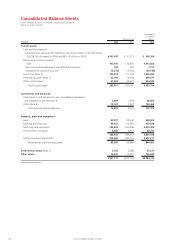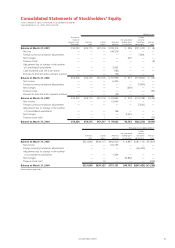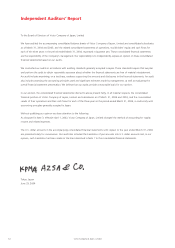JVC 2004 Annual Report Download - page 49
Download and view the complete annual report
Please find page 49 of the 2004 JVC annual report below. You can navigate through the pages in the report by either clicking on the pages listed below, or by using the keyword search tool below to find specific information within the annual report.
Annual Report 2004 47.
Liability for employees’ retirement benefits included in liabilities in the consolidated balance sheets for 2004 and 2003 and the related
expenses for 2004, 2003 and 2002, which were determined based on the amounts obtained by actuarial calculations, are as follows:
Thousands of
Millions of yen U.S. dollars
2004 2003 2004
Projected benefit obligation:
Projected benefit obligation ¥(158,211) ¥(164,185) ¥(1,492,557)
Unamortized prior service costs — ——
Unamortized actuarial differences 27,624 55,865 260,604
Less fair value of plan assets 94,377 75,037 890,349
Less unrecognized net transition obligation 17,623 19,225 166,255
Liability for severance and retirement benefits ¥ (18,587) ¥ (14,058) ¥ (175,349)
Thousands of
Millions of yen U.S. dollars
2004 2003 2002 2004
Severance and retirement benefits expenses:
Service costs ¥ 6,973 ¥ 7,103 ¥ 8,200 $ 65,783
Interest costs on projected benefit obligation 4,795 6,383 8,884 45,236
Expected return on plan assets (2,000) (3,080) (4,499) (18,868)
Amortization of net transition obligation 1,603 1,994 2,779 15,122
Amortized actuarial differences 5,039 3,151 1,610 47,538
Amortized prior service costs —(297) (890) —
Severance and retirement benefits expenses 16,410 15,254 16,084 154,811
Gain on return of substitutional portion of Employees’ Pension Insurance —3,456 — —
Total ¥16,410 ¥11,798 ¥16,084 $154,811
Not included in the above table is special retirement payments
amounting to ¥452 million ($4,264 thousand), ¥4,260 million
and ¥1,199 million which were expensed in 2004, 2003 and
2002, respectively.
The discount rate and the rate of expected return on plan assets
used by the Company are 2.7% and 3.0% in 2004, and 3.0%
and 3.0% in 2003, and 3.5% and 3.0% in 2002, respectively.
The estimated amount of all retirement benefits to be paid at
future retirement dates is allocated equally to each service year
using the estimated number of total service years. Prior service
costs are recognized in income or expense using the straight-line
method over 10 years, and actuarial gains and losses are recognized
in income or expense using the straight-line method over 10 years
commencing with the following period.
10. CONTINGENT LIABILITIES
The contingent liabilities of the Companies at March 31, 2004 are
as follows:
Thousands of
Millions of yen U.S. dollars
As endorser of export bills discounted
with banks ¥6,558 $61,868
As guarantor for loans to employees 2,267 21,387
As guarantor for lease obligations
of affiliated company and others 349 3,292
¥9,174 $86,547
11. STOCKHOLDERS’ EQUITY
Under the Japanese Commercial Code (the “Code”), at least
50% of the issue price of new shares is required to be desig-
nated as stated capital. The portion which is to be designated
as stated capital is determined by resolution of the Board of
Directors. Proceeds in excess of the amounts designated as
stated capital are credited to additional paid-in capital, which is
included in capital surplus.
The Code provides that an amount equal to at least 10% of
cash dividends and other cash appropriations shall be appropriated
and set aside as a legal earnings reserve until the total amount of
legal earnings reserve and additional paid-in capital equals 25% of
common stock.
The legal earnings reserve and additional paid-in capital may be
used to eliminate or reduce a deficit by resolution of the stock-
holders’ meeting or may be capitalized by resolution of the Board
of Directors.
On condition that the total amount of legal earnings reserve
and additional paid-in capital remains being equal to or exceeding
25% of common stock, they are available for distributions or
certain other purposes by the resolution of stockholders’ meeting.
Legal earnings reserve is included in retained earnings in the
accompanying financial statements.
The maximum amount that the Company can distribute as
dividends is calculated based on the non-consolidated financial
statements of the Company and in accordance with the Code.
In accordance with customary practice in Japan, the appropria-
tions are not accrued in the financial statements for the period to
which they relate, but are recorded in the subsequent accounting
period after the stockholders’ approval has been obtained.
Retained earnings at March 31 2004, include amounts representing
the year-end cash dividends of Yen 1,270 million Yen 5.00 per
share, and directors’ bonuses of Yen 45 million, which were
approved at the stockholders’ meeting held on June 29,2004.
12. DERIVATIVE FINANCIAL INSTRUMENTS
The Companies use derivative financial instruments in the
normal course of their business to manage the exposure to
fluctuations in foreign exchange rates and interest rates. The
primary derivative financial instruments used by the Companies
are forward exchange contracts, option contracts and interest
rate swap contracts.
























